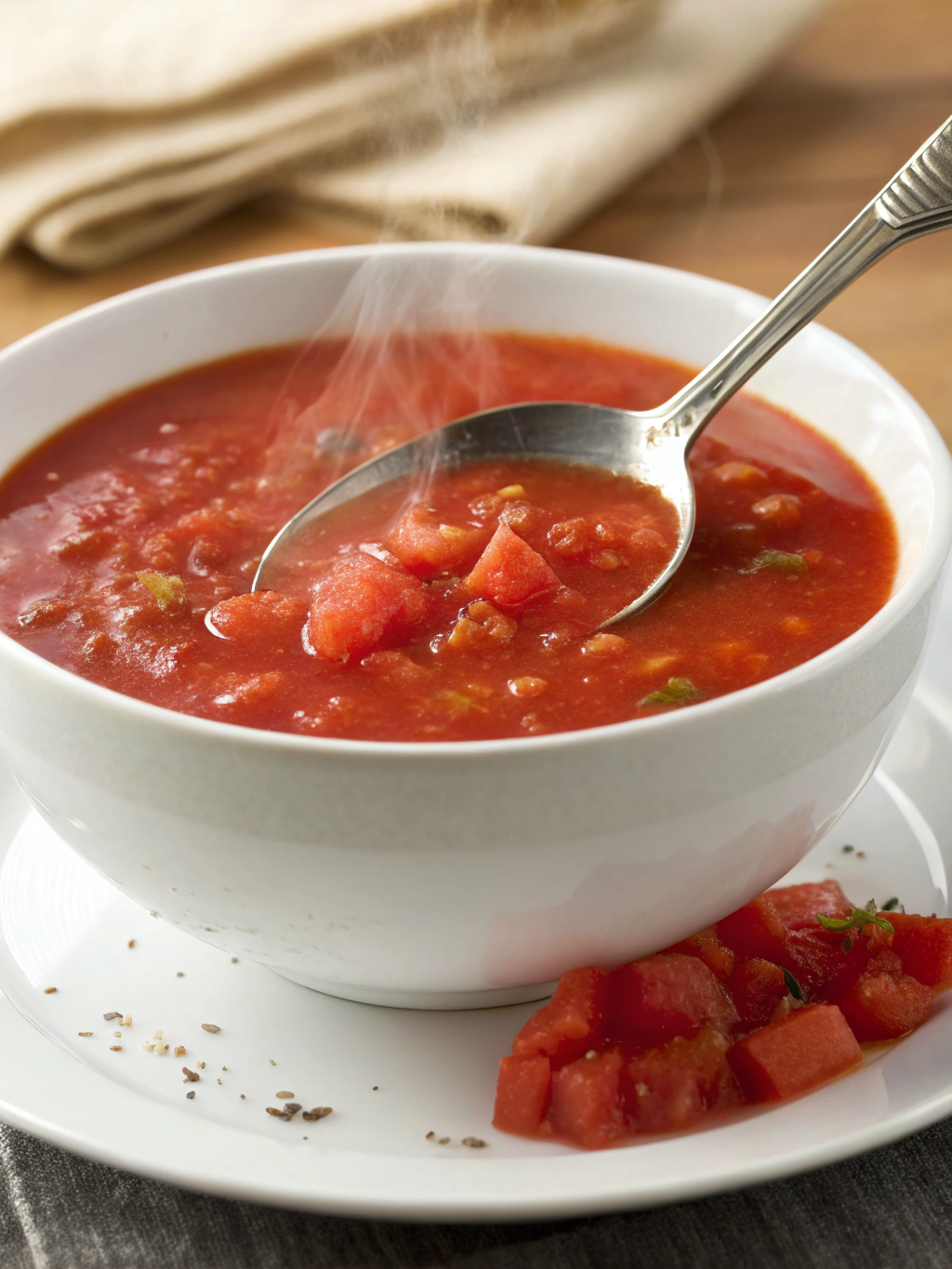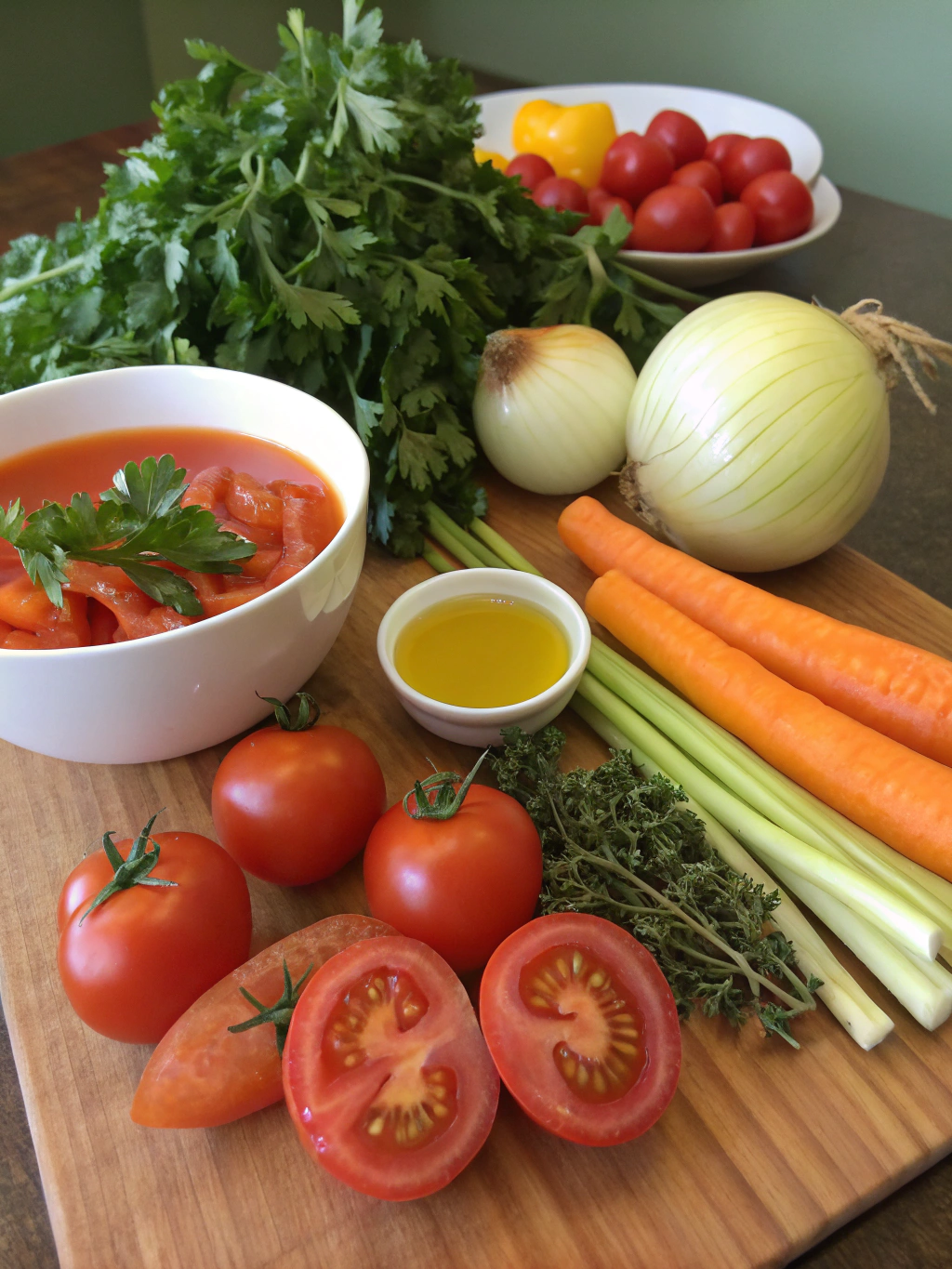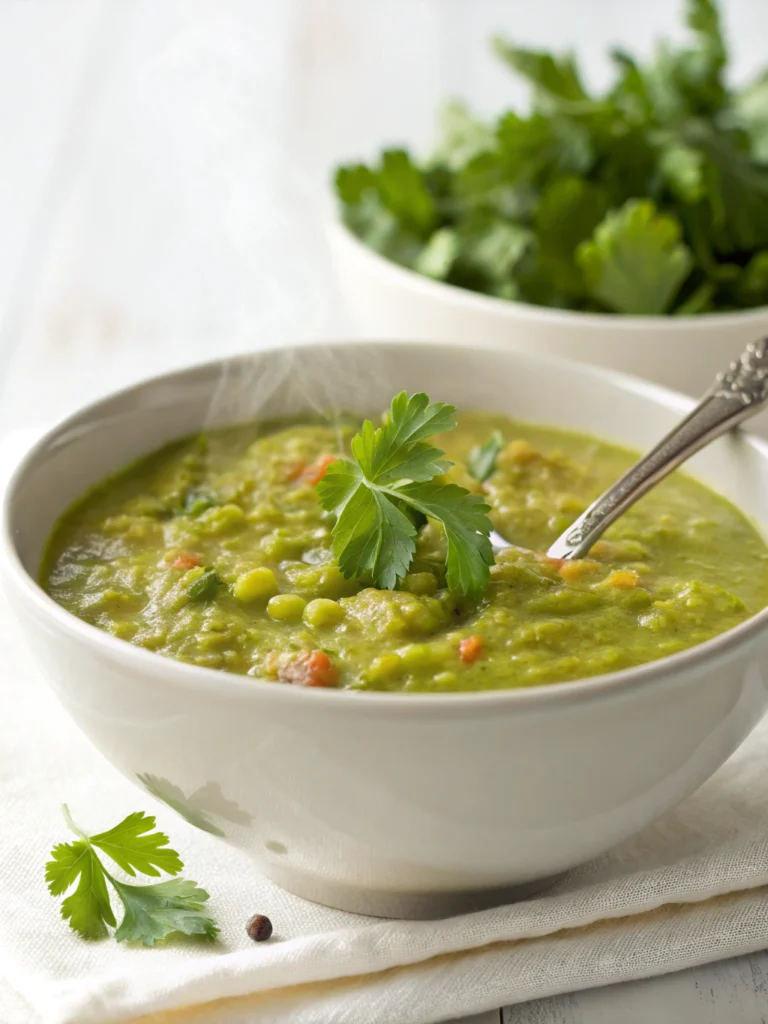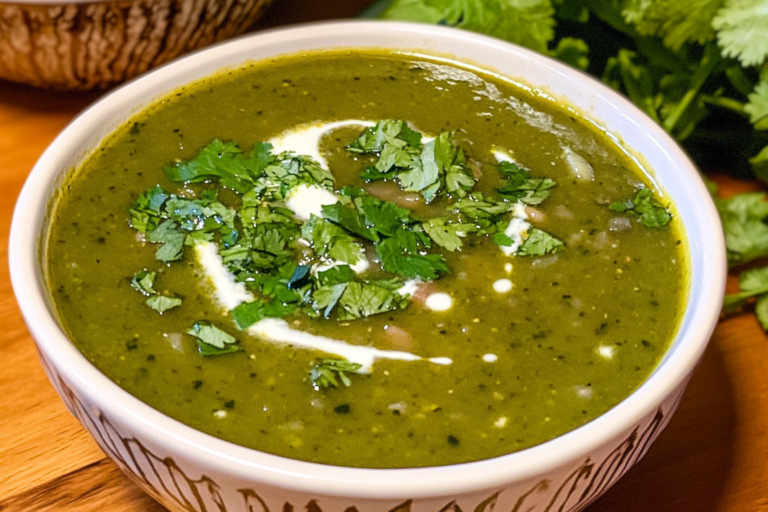Tomato Soup
A velvety, rich tomato soup that achieves the perfect balance of tangy tomatoes, aromatic herbs, and creamy texture. This homemade favorite comes together in just 40 minutes but tastes like it simmered all day.
Easy Tomato Soup Recipe
There’s something deeply comforting about a bowl of homemade tomato soup that canned varieties simply can’t match. This classic tomato soup recipe transforms simple ingredients into a silky, flavor-packed dish that feels like a warm hug on a chilly day. What makes this version special is the perfect balance of acidity and sweetness, achieved without artificial ingredients or excessive sugar.
Tomato soup has been a staple comfort food for generations, but it takes on special significance during late summer and early fall when garden tomatoes reach their peak ripeness. This recipe works beautifully with both fresh, in-season tomatoes or high-quality canned tomatoes when fresh aren’t available, making it a year-round favorite.
THIS RECIPE:
- Made with simple, pantry-friendly ingredients
- Ready in under 45 minutes from start to finish
- Easily customizable for dietary preferences
- Freezer-friendly for make-ahead meal planning
| Recipe Details | |
|---|---|
| Prep Time | 10 minutes |
| Cook Time | 30 minutes |
| Total Time | 40 minutes |
| Servings | 4 bowls (about 6 cups) |
| Calories | Approximately 210 per serving |
This easy tomato soup recipe requires minimal hands-on time but delivers maximum flavor. The recipe methodology concentrates the natural sweetness of tomatoes while building layers of flavor with aromatic vegetables and fresh herbs. The result is a soup that tastes complex and sophisticated despite its straightforward preparation. Perfect for weeknight dinners or as a starter for special occasions, this versatile tomato soup pairs beautifully with grilled cheese sandwiches or a rustic bread for a complete meal.
Ingredients for Tomato Soup
The secret to an exceptional tomato soup lies in the quality of your ingredients. Since this recipe has relatively few components, each one significantly impacts the final flavor. Opt for the ripest tomatoes you can find if using fresh, or choose high-quality canned tomatoes (San Marzano are ideal) for consistent results year-round.
Main Ingredients:
- 2 tablespoons olive oil
- 1 medium onion, finely diced
- 2 medium carrots, finely diced
- 2 celery stalks, finely diced
- 4 garlic cloves, minced
- 2 tablespoons tomato paste
- 2 pounds fresh ripe tomatoes, chopped (or 28 oz canned whole peeled tomatoes)
- 4 cups vegetable broth (or chicken broth for non-vegetarians)
- 2 bay leaves
- 2 sprigs fresh thyme
- 1 teaspoon sugar (optional, to balance acidity)
- 1/2 cup heavy cream (optional, for creamier texture)
- Salt and freshly ground black pepper, to taste
For Garnish:
- Fresh basil leaves, thinly sliced
- Parmesan cheese, freshly grated
- Croutons (homemade or store-bought)
- Swirl of extra virgin olive oil
| Ingredient Category | Recommended Quality | Selection Tips |
|---|---|---|
| Tomatoes | Vine-ripened or Roma | Choose tomatoes that are deep red, fragrant, and slightly soft to touch |
| Canned Tomatoes | San Marzano or fire-roasted | Look for whole peeled with no added ingredients except salt |
| Broth | Low-sodium | Homemade provides best flavor, but quality store-bought works well |
| Herbs | Fresh when possible | Fresh basil and thyme dramatically improve flavor |
| Dairy | Heavy cream with high fat content | Higher fat percentage creates silkier texture |
Pro Tip: If using fresh tomatoes, consider blanching and peeling them first for an ultra-smooth soup. Simply score an “X” on the bottom of each tomato, blanch in boiling water for 30 seconds, then immediately transfer to ice water. The skins will slip off easily.
How to Make Tomato Soup
Creating homemade tomato soup involves building layers of flavor through proper sautéing of aromatics, careful simmering to concentrate flavors, and finally blending to achieve that signature velvety texture. The process is straightforward but pays huge dividends in taste compared to store-bought alternatives.
Prepare the aromatic base
- Heat olive oil in a large pot or Dutch oven over medium heat.
- Add diced onions, carrots, and celery (the classic “mirepoix”).
- Sauté for 7-8 minutes until vegetables are soft but not browned.
- Add minced garlic and cook for another 30 seconds until fragrant.
Develop deep flavor
- Add tomato paste to the aromatics and cook for 2 minutes, stirring constantly.
- This caramelizes the tomato paste, creating a richer, more complex flavor foundation.
Add tomatoes and liquid
- Add chopped fresh tomatoes or canned tomatoes with their juice.
- Pour in vegetable broth and stir to combine.
- Add bay leaves, thyme sprigs, and sugar (if using).
- Season with salt and freshly ground black pepper.
Simmer the soup
- Bring mixture to a gentle boil, then reduce heat to maintain a simmer.
- Cover partially with a lid and simmer for 20-25 minutes until tomatoes break down and flavors meld.
Blend until smooth
- Remove bay leaves and thyme sprigs.
- For the smoothest texture, use an immersion blender directly in the pot.
- Alternatively, carefully transfer soup in batches to a standard blender (be cautious with hot liquid).
- Blend until completely smooth.
Finish the soup
- Return blended soup to the pot if using a standard blender.
- If using cream, stir it in now and gently warm (do not boil after adding cream).
- Taste and adjust seasoning with additional salt and pepper as needed.
Pro Tip: For extra-smooth soup, pass the blended mixture through a fine-mesh sieve before returning to the pot. This removes any seeds or fibrous bits for the silkiest possible texture.
Tips for Making Tomato Soup
Creating the perfect tomato soup requires attention to detail and understanding of how ingredients work together. These tips will help you customize and perfect your soup every time.
Balance acidity: Tomatoes naturally contain acids that can sometimes taste too sharp. If your soup tastes overly acidic:
- Add a pinch of baking soda (it neutralizes acid)
- Include a tablespoon of honey or maple syrup instead of refined sugar
- Add a parmesan rind during simmering (remove before blending)
Texture variations: Adapt the consistency to your preference:
- For ultra-smooth: strain through a fine-mesh sieve after blending
- For rustic texture: pulse rather than fully blend, or reserve some of the sautéed vegetables before blending
- For extra body without cream: blend in 1/2 cup soaked cashews or add a peeled, boiled potato
Flavor enhancers: Boost depth without additional ingredients:
- Roast your tomatoes before adding them to concentrate flavor
- Use fire-roasted canned tomatoes for smoky undertones
- Add a splash of balsamic vinegar at the end of cooking
- Include a parmesan rind during simmering (remove before blending)
| Technique | Effect | Best For |
|---|---|---|
| Roasting tomatoes | Concentrates sweetness, reduces acidity | Fresh tomatoes that lack flavor |
| Simmering with herbs | Infuses aromatic compounds | All versions, especially winter versions |
| Adding cream at end | Creates silky texture without reducing flavor | Special occasions, richer presentation |
| Garnishing with fresh herbs | Brightens and adds visual appeal | All versions, especially when serving guests |
Make-Ahead Instructions
Tomato soup is ideal for make-ahead meal planning, as the flavors actually improve when allowed to meld overnight. This makes it perfect for busy weeknights or entertaining.
For best results when preparing in advance:
- Complete the recipe through the blending step, but do not add cream.
- Cool the soup completely at room temperature (no more than 2 hours).
- Transfer to airtight containers, leaving 1/2 inch of headspace if planning to freeze.
- Refrigerate for up to 3 days or freeze for longer storage.
- When ready to serve, reheat gently on the stovetop over medium-low heat.
- Add cream only after reheating if including in your recipe.
You can also prepare components in advance to streamline the cooking process:
- Chop all vegetables up to 24 hours ahead and store in airtight containers in the refrigerator.
- If using fresh tomatoes, blanch, peel, and chop up to 2 days in advance.
- Prepare homemade broth up to 5 days ahead or freeze for longer storage.
Pro Tip: If making soup specifically to freeze, consider omitting the cream entirely and adding it fresh when reheating just before serving. This prevents any potential separation issues during freezing.
Storing Leftovers
Proper storage is key to maintaining the flavor and food safety of your homemade tomato soup.
For refrigerated storage:
- Cool soup completely before refrigerating, but don’t leave at room temperature for more than 2 hours.
- Transfer to shallow containers to speed cooling and prevent bacterial growth.
- Store in airtight containers to prevent absorption of other food odors.
- Refrigerated tomato soup will keep well for 3-4 days.
- If cream has been added, gently reheat over low heat to prevent separation.
When reheating refrigerated soup:
- Transfer desired portion to a saucepan.
- Heat over medium-low heat, stirring occasionally.
- Warm until it reaches at least 165°F (74°C) for food safety.
- Add a splash of broth or water if the soup has thickened during storage.
Safety Note: Never reheat soup multiple times. Only reheat the portion you plan to consume immediately to maintain food safety and quality.
Freezing Tomato Soup
Tomato soup freezes exceptionally well, making it perfect for batch cooking and meal preparation. For best results when freezing:
Prepare for freezing:
- Cool soup completely before freezing (within 2 hours of cooking).
- If adding cream, freeze the soup without it and add cream after thawing.
- Portion soup into meal-sized containers or freezer bags.
- Leave 1/2-inch headspace in rigid containers to allow for expansion.
Packaging methods:
- For individual portions: Freeze in silicone muffin cups, then transfer frozen portions to freezer bags.
- For family meals: Use freezer-safe containers with tight-fitting lids.
- For space-saving storage: Freeze flat in ziplock freezer bags on a baking sheet, then stack.
Thawing and reheating:
- Thaw overnight in the refrigerator for best results.
- For quick thawing, place sealed container in cold water, changing water every 30 minutes.
- Reheat gently on stovetop over medium-low heat, stirring occasionally.
- Add fresh cream after reheating if desired.
- Refresh flavors with a squeeze of lemon juice and fresh herbs.
Frozen tomato soup maintains quality for 4-6 months but remains safe indefinitely at 0°F or below.
Serving Suggestions
A bowl of homemade tomato soup can stand alone as a light meal or serve as a remarkable starter. Elevate your serving with these complementary pairings:
Classic Accompaniments:
- Grilled cheese sandwich made with sharp cheddar on sourdough bread
- Buttery garlic bread or crusty baguette slices
- Cheese and herb biscuits or popovers
- Simple green salad with vinaigrette dressing
Toppings to Elevate Your Soup:
- Homemade croutons tossed with olive oil, garlic, and herbs
- Swirl of cream, crème fraîche, or Greek yogurt
- Crispy bacon bits or pancetta
- Toasted pine nuts or pumpkin seeds
- Fresh basil chiffonade or microgreens
- Parmesan cheese crisps or freshly grated Parmesan
- Drizzle of basil oil or chili oil for color and flavor
Beverage Pairings:
- White wine: Pinot Grigio or Sauvignon Blanc
- Red wine: Light Pinot Noir or Chianti
- Beer: Wheat beer or light lager
- Non-alcoholic: Sparkling water with lemon or iced tea
Serve tomato soup hot but not scalding (around 165°F/74°C) in warmed bowls to maintain temperature throughout the meal. For formal occasions, consider serving in cups as a starter or in shot glasses as an elegant amuse-bouche.
FAQ
Can I make tomato soup without a blender?
Yes! While blending creates that signature smooth texture, you can make a rustic version without a blender. Simply chop your vegetables very finely before cooking, and use crushed tomatoes instead of whole. After simmering, you can use a potato masher to break down any larger pieces. The result will be more textured but equally delicious.
What can I substitute for heavy cream to make this dairy-free?
Several options work well for a dairy-free tomato soup:
- Full-fat coconut milk (the canned variety)
- Cashew cream (blend 1/2 cup soaked raw cashews with 1/2 cup water)
- Plant-based cream alternatives like oat or almond cream
- Puréed white beans or cauliflower for added creaminess without dairy
My tomato soup tastes too acidic. How can I fix it?
The acidity in tomato soup can be balanced several ways:
- Add a pinch of baking soda (1/4 teaspoon) and stir as it foams—this neutralizes acid
- Incorporate a tablespoon of butter or a splash of cream
- Add 1-2 teaspoons of honey or maple syrup
- Include a grated carrot during cooking for natural sweetness
- Ensure you’re using ripe tomatoes, which are naturally less acidic
Can I use dried herbs instead of fresh?
Absolutely! When substituting dried herbs for fresh, use about 1/3 the amount called for in the recipe. For this soup, use 1 teaspoon dried basil and 1/2 teaspoon dried thyme in place of fresh sprigs. Add dried herbs earlier in the cooking process (with the broth) to allow their flavors to fully develop during simmering.
How can I thicken my tomato soup if it’s too thin?
If your soup needs thickening:
- Simmer uncovered for 5-10 minutes to reduce liquid through evaporation
- Make a slurry with 1 tablespoon cornstarch and 2 tablespoons cold water, then stir into simmering soup
- Add 2-3 tablespoons tomato paste
- Blend in 1/4 cup of instant potato flakes
- Purée and add a slice of bread (remove crusts first) directly into the soup while blending
Remember that soup will naturally thicken somewhat as it cools, so avoid over-thickening during cooking.








